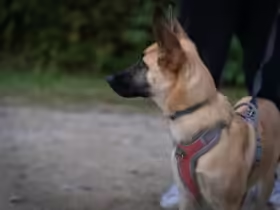Introduction
Training your dog to be off-leash is a significant milestone in your pet’s development, offering them freedom while enhancing the bond between you two. However, it comes with great responsibility. Ensuring your dog’s safety and obedience off-leash requires time, patience, and the right techniques. This comprehensive guide will provide you with everything you need to know about training your dog to be off-leash, including safety tips, essential techniques, and practical advice.
Understanding the Basics
Why Off-Leash Training Is Important
Off-leash training is crucial for several reasons:
- Freedom and Exercise: It allows your dog to explore and exercise more freely, contributing to their physical and mental health.
- Strengthening the Bond: Trusting your dog off-leash strengthens the bond between you, enhancing communication and understanding.
- Safety in Uncontrolled Environments: In case of an accidental leash slip, off-leash training ensures your dog remains under control and safe.
Prerequisites for Off-Leash Training
Before starting off-leash training, ensure your dog:
- Has Basic Obedience Training: Commands like sit, stay, come, and heel should be well understood.
- Is Socialized: Your dog should be comfortable around other dogs, people, and distractions.
- Has Reliable Recall: A strong and reliable recall command is essential for off-leash safety.
Safety Tips for Off-Leash Training
Choose the Right Environment
Start training in a controlled, safe environment:
- Fenced Areas: Begin in fenced parks or enclosed spaces where your dog cannot run too far.
- Quiet Areas: Choose places with minimal distractions initially to keep your dog focused.
Use a Long Leash Initially
Using a long leash (15-30 feet) helps transition your dog to off-leash freedom while maintaining control:
- Control Distance: A long leash gives your dog a sense of freedom while allowing you to reinforce commands.
- Practice Recall: Use the long leash to practice recall and other obedience commands at increasing distances.
Keep a Close Eye on Your Dog’s Body Language
Understanding your dog’s body language is key to preventing accidents:
- Signs of Anxiety or Discomfort: Watch for signs like raised hackles, stiff posture, or excessive panting, which indicate stress.
- Prey Drive: Be alert to signs of a strong prey drive, such as intense staring or crouching, which could lead to chasing wildlife.
Always Carry Treats or Rewards
Positive reinforcement is essential:
- High-Value Treats: Use your dog’s favorite treats to reinforce good behavior and successful recall.
- Praise and Affection: Combine treats with verbal praise and petting to strengthen the positive association with obeying commands.
Techniques for Successful Off-Leash Training
1. Mastering Recall
- Start on Leash: Begin recall training on a regular leash, gradually increasing the distance.
- Use a Command: Consistently use a specific word or phrase like “come” for recall.
- Reward Immediately: Reward your dog as soon as they respond to the recall command.
2. Gradual Distance Increase
- Use a Long Leash: Transition to a long leash once your dog reliably responds to the recall command.
- Increase Distance Slowly: Gradually increase the distance between you and your dog while practicing recall.
- Introduce Distractions: Slowly introduce distractions while maintaining control over your dog’s response.
3. Proofing Behaviors
- Practice in Different Environments: Train in various locations to ensure your dog obeys commands everywhere.
- Vary Distractions: Incorporate different levels of distractions to proof your dog’s obedience in all situations.
- Consistency is Key: Be consistent with commands and rewards in every environment.
4. Emergency Recall
- Teach an Emergency Command: Use a distinct, rarely used command for emergency situations.
- High-Value Rewards: Reserve the best treats for when your dog successfully responds to the emergency recall.
Advanced Off-Leash Techniques
1. Off-Leash Heel
- Start on Leash: Train the heel command with a leash before attempting it off-leash.
- Gradual Transition: Gradually reduce leash use, starting with short distances.
- Practice Off-Leash in Controlled Areas: Once reliable, practice in enclosed, low-distraction environments.
2. Using a Remote Collar (Optional)
- Understand the Tool: A remote collar can be a useful tool if used correctly, but it should be used with caution and never as a punishment.
- Professional Guidance: Consider consulting a professional trainer before using a remote collar.
- Positive Reinforcement: Use the collar in conjunction with positive reinforcement techniques.
Troubleshooting Common Challenges
1. Ignoring Recall
- Reinforce Recall Training: If your dog starts ignoring recall, go back to basics with a long leash and high-value treats.
- Increase Value of Rewards: Use more enticing rewards to make responding more appealing to your dog.
2. Chasing After Distractions
- Control the Environment: Train in distraction-free areas until recall is reliable.
- Redirect Focus: Use toys or treats to redirect your dog’s attention from distractions.
3. Running Away
- Leash Again: If your dog bolts, return to leash training and work on recall.
- Address Anxiety or Fear: If running away is due to fear, work on desensitization to the triggers.
Maintaining Off-Leash Reliability
Consistent Practice
- Regular Training Sessions: Continue practicing recall and other commands regularly, even after your dog is reliably off-leash.
- Vary Locations: Practice in different environments to maintain your dog’s responsiveness.
Positive Reinforcement
- Ongoing Rewards: Continue to reward your dog for good behavior, even when off-leash training is complete.
- Maintain a Positive Association: Ensure your dog associates off-leash behavior with positive experiences.
Safety Precautions
- Always Carry a Leash: Keep a leash with you at all times in case you need to regain control.
- Identification: Ensure your dog wears a collar with ID tags and is microchipped for safety.
Conclusion
Training your dog to be off-leash is a rewarding process that requires time, patience, and consistency. By following the safety tips and techniques outlined in this guide, you can help ensure your dog’s off-leash experiences are safe, enjoyable, and stress-free. Remember, off-leash training is an ongoing commitment, but the freedom and joy it brings to both you and your dog are well worth the effort.











Leave a Reply